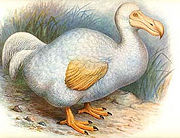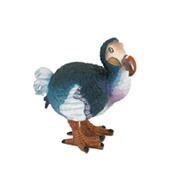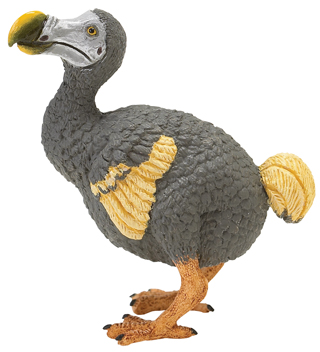New Dodos
Posted by: Loren Coleman on June 11th, 2008

The dodo (Raphus cucullatus) was a flightless bird endemic to the Indian Ocean island of Mauritius, and went extinct several centuries ago, we are told.
But there remains some controversy surrounding the extinction date of the dodo.
In Nature 426, 245 (20 November 2003), David L. Roberts and Andrew R. Solow write in their paper, “Flightless birds: When did the dodo become extinct?” that “the extinction of the Dodo is commonly dated to the last confirmed sighting in 1662, reported by shipwrecked mariner Volkert Evertsz” (Evertszoon).
Other sources, however, suggest the date is 1681. Roberts & Solow point out that because the sighting prior to 1662 was in 1638, the dodo was likely already very rare by the 1660s, and that thus a disputed report from 1674 cannot be dismissed out-of-hand.
Statistical analysis of the hunting records of Issac Johannes Lamotius give a new estimated extinction date of 1693, with a 95% confidence interval of 1688 to 1715.
Considering more circumstantial evidence such as travellers’ reports and the lack of good reports after 1689, it is likely that the dodo became extinct before 1700. Sadly, the last Dodo died little more than a century after the species’ discovery in 1581.
Reports of sightings of living dodos in the 1990s on Mauritius prompted cryptozoologist William (“Bill”) Gibbons to mount expeditions to search for them. None were found.
Quite remarkably, dodos are back with us briefly and you can have two in the hand, instead of leaving any in the bush.
What I want to mention to readers of Cryptomundo is that two rather good small replicas of the dodo have appeared on the animal figurine scene this year. I would recommend to collectors and small exhibitors you may wish to pick them up before they become “extinct.”
They are hand-painted and quite beautiful.

One is from Papo, a French animal figurine maker.

The other is from the company Safari Ltd., headquartered in Florida and France. Of the two, it appears to be the more life-like and accurate to coloring. Dodos were a dull appearing bird, said to be gray to white. After all, dodos, while quite famous, are merely flightless, overgrown relatives of the pigeons. The dodo replica from Safari is highly recommended for your cryptozoological collection.
They hardly were here before they were gone, and the same thing could happen all over again.
Dodos’ destinies seem tied to disappearing.
About Loren Coleman
Loren Coleman is one of the world’s leading cryptozoologists, some say “the” leading living cryptozoologist. Certainly, he is acknowledged as the current living American researcher and writer who has most popularized cryptozoology in the late 20th and early 21st centuries.
Starting his fieldwork and investigations in 1960, after traveling and trekking extensively in pursuit of cryptozoological mysteries, Coleman began writing to share his experiences in 1969. An honorary member of Ivan T. Sanderson’s Society for the Investigation of the Unexplained in the 1970s, Coleman has been bestowed with similar honorary memberships of the North Idaho College Cryptozoology Club in 1983, and in subsequent years, that of the British Columbia Scientific Cryptozoology Club, CryptoSafari International, and other international organizations. He was also a Life Member and Benefactor of the International Society of Cryptozoology (now-defunct).
Loren Coleman’s daily blog, as a member of the Cryptomundo Team, served as an ongoing avenue of communication for the ever-growing body of cryptozoo news from 2005 through 2013. He returned as an infrequent contributor beginning Halloween week of 2015.
Coleman is the founder in 2003, and current director of the International Cryptozoology Museum in Portland, Maine.










Thanks for bringin up this fascinating subect. Mysterious and frustrating how such a cipher of natural science continues to perplex us, its dissappearing just before the dawn of modern biology. I’ve heard that a few small remains show it’s DNA has it related to pigeons, and that other remote islands in the south Atlantic likewise has theirown endemic species of giant flightless birds noted for their beauty…and succulent flesh. Maybe eco-restoration efforts will be able to revive these species in the future.
This is a very good example of a species that was completely unprepared for an influx of invasive species to its remote habitat, including humans. The dodo is a fascinating look at how spectacularly an isolated species can be wiped out and be totally defenseless against it. The same kind of thing has happened to island adapted species time and time again. These are typically fragile ecosystems, sensitive to change and easily upset. They also tend to have specialized or uniquely adapted creatures with little defense against introduced factors. The dodo is a sad case, but it is unfortunately not the only case like this.
Interesting article. I was not aware that the date of extinction of the dodo was in dispute. I also didn’t know there were such modern alleged sightings of the bird. It seems unlikely that any remain. This wasn’t exactly a tenacious species able to effectively deal with changes to its habitat and threats from domestic animals. It was actually quite a slow, helpless little thing. That being said, what a treat it would be to suddenly be presented with one!
David Quammen, in The Song of the Dodo, punctuated his factual account of the species with an imagined tale of the last bird. It’s as poignant as any nature writing I ever read.
“Raphus cucullatus had become rare unto death. But this one flesh-and-blood individual still lived. Imagine that she was thirty years old, or thirty-five, an ancient age for most sorts of bird but not impossible for a member of such a large-bodied species. She no longer ran, she waddled. Lately she was going blind. Her digestive system was balky. In the dark of an early morning in 1667, say, during a rainstorm, she took cover beneath a cold stone ledge at the base of one of the Black River cliffs. She drew her head down against her body, fluffed her feathers for warmth, squinted in patient misery. She waited. She didn’t know it, nor did anyone else, but she was the only dodo on Earth. When the storm passed, she never opened her eyes. This is extinction.”
Appreciate both David Quammen’s and Mystery Man’s perspectives but those aside, it is a most poignant comment on human impacts (and their domestic animals) that on every island we (modern humans) ever attempted to “civilize” where ever there were flightless birds, they are effectively made extinct, extirpated in short order. It speaks more to human ignorance, thoughtlessness and irresponsibility rather than the fragility of these island adapted species and the community of other organism which depended on them for continuance, and which should have served if only we’d been wise enough to recognize it, as supreme examples of nature’s adaptability, persistence, and durability.
All the more reason, in my opinion, for trying to scrape together the DNA from what museum specimens that might remain in hopes of reviving them.
Since both replicas display two very different set of coloring in the plumage, I would like to know which one is closer to the truth. Or did the dodos display all those colorings and more, like the doves?
Dodos, of course, were just land-locked oversized relatives of pigeons/doves, so they seemed to be able to develop a variety of colorations. Albinos were noted, and some well-known art depicts the beauty of the dodos.
The “plump” nature of the dodo, however, is in disfavor, as those descriptions appeared based on fattened captive specimens.
Very funny. Have any of you seen the documentary that was on the Discovery Channel that said that dinosaurs could be re-created by genetically changing birds like emus? They could recreate a dodo look-alike from a dove or a chicken.
It would be cool if they made a living Dodo look-alike.
Great post, Loren…
And I love the David Quammen excerpt.
Truly awesome (and tragic) piece of writing.
It would we great if they gentically regenerate them.
One can only wish.
Unlike Dogu4, I’m not necessarily as down on the human race as he is. Yes, we have done a lot of thoughtless, irresponsible things in regards to the ecosystem, but we’ve also exhibited the great ability to learn form these mistakes and do right. A lot of the tragedies that happened in the past regarding creatures like the dodo happened because knowledge of the interconnectedness of all life had not manisfested itself in human consciousness yet. It was there under the surface, but had not come up yet.
The tragedy with the dodo did happen over 300 years ago, one must remember.
Although we have a long way to go in regards to safeguarding and maintaining a good relationship with animals and the Earth, we have learned much and are now more aware. We’re getting there. We’re still ignorant of some things, but the light is beginning to break through. That is my simple opinion, cautious optimist that I am.
Thanks for the extra input about the dodo’s coloation, Loren 🙂
cryptidsrus- While I agree that in some areas we have made progress in undoing some of the damage we have done, it also has to be remembered that in cases such as this, the threat to native animals and ecologies is not always due to intentional human destruction or active extermination. One of the big threats facing the dodo, for example, was not just human hunting (the meat was purportedly not even very good), but rather the introduction of animals such as dogs, cats, and even pigs and a type of macaque. The dogs and cats actively preyed upon them, and the pigs and macaques ate the dodo’s eggs.
Very often, invasive species are introduced to a new habitat by accident, as pets, sometimes even with the intention of HELPING the ecosystem. These invasive species can cause great destruction and even extinctions without us always being fully aware of the consequences the introduced plants or animals would have.
While it is true we understand more about the interaction of life on this planet than we once did, in some cases we don’t know much more about how an ecology will react to a given invasive species than we did 300 years ago. Ecology is a very complex thing. It can be often very difficult to ascertain the exact effects a non-indigenous plant or animal will have on local flora and fauna or in what way the ecology will shift or react to these new factors.
We live in a world where planes, ships, and other forms of travel are more or less making it possible for any species to show up anywhere, essentially blurring the lines between habitats that have been separated and evolved in their own unique ways and sort of creating one super continent. I think that one of the main problems facing these types of species is not necessarily human maliciousness, but rather just carelessness and a lack of understanding of what the effects of such shuffling of species to different areas can have.
My mom said that in Mexico, that she saw a bird that looked like a Dodo, but was gray and could almost fly. It went on roof of the house. and flew very well but not as good because it was very fat.
dogu4,
How about Emu, Ostrich, Rhea, Cassowary (ok not a great example)? Animals from larger continents as a rule are ecologically more resilient that small island species and as such can tolerate certain pressures better such as that of invasive species including or also man
If I am right the preserved remains of the bird are also in threat of extinction! Very few good examples still exist making any significant DNA extraction more difficult
Interestingly I have at home a plaster cast of the head of an example which I believe is held at held at the Natural History Museum London!
Ranatemporaria: good points, though I think you can see where those examples you mentioned hadn’t adapted to what were isolated and essentially predator-free ecosystems where the birds essentially functioned as grazing/browsing animals in keystone positions that we typically associate with ruminants. Additionally, if we’re just talking about the impacts of human contact, one could also mention the moas of New Zealand, the “elephand bird” of Madagascar, and if we consider the oceanic environments we could include the giant auks of the North Atlantic and Stellers Giant cormorants of the Aleutians..and the latest nonminees: California’s Giant Seaduck and what appears to be a similar species on the Hawaiian islands…so, when I refer to civilization I don’t simply mean to implicate Europeans or even modern civilizations or cultures.
My point is not that people are so bad but that we could justify attempts to recreate or reconstruct effectively impoverished ecosystems using modern genetically engineered surrogates to something approaching their fully productive complexity using modern techniques, since its degenerate state was caused by human actions which by modern standards would all but constitute criminal negligence.
Cheers.
Dogu4- I’m all for genetically recreating impoverished ecosystems, or supplementing a degraded ecosystem through the reintroduction of similar creatures that have left biological niches unfilled. It’s a very fascinating topic of discussion for me.
Aztec, while it would be nice I doubt you could re-create a dodo-like animal from a living bird species. It’s much more likely to be able to re-create a dinosaur-like animal because all birds are descended from dinosaurs and thus still carry the genetic material their ancestors had. Unless chickens or doves evolved from the dodo (they didn’t) it would not be possible.
As for what your mom saw, I wonder if perhaps it was a guineafowl?
My mom said that she saw the bird on roof of the house. and flew very well but not as good because it was very fat. It the Size of a turkey, but it was gray, had no tail, and could almost fly. This was at night but my mom lived a farming town. She has seen guineafowl, chicken and all the birds seen in the area of Almoloya, Hidalgo. She only saw the body not the head of the bird. My aunt was there so she may have more information. But when I showed her a picture of the Dodo on June 11 2008, she told me about it. she said the body was the same shape.
I also think it would be cool if they made a living Dodo look-alike and that’s what I thought this post was about when I first read the title. 🙂
Hey YourPTR! and maslo63, it is may be possible to create a living Dodo look-alike. It can be made by first breeding flightless, small winged pigeons.then create and breed other Characteristics of a dodo in to pigeons.